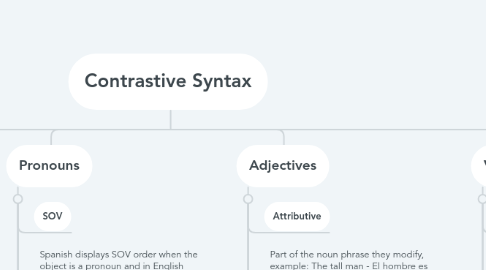Contrastive Syntax
by Andrik Macías

1. Syntactic category
1.1. Grammatical units
1.1.1. Nouns, verbs and adjectives.
1.2. Parts of speech
1.2.1. Noun, verb and adverb phrases
1.3. Phrases
1.3.1. Clauses, texts and sentences
2. Verbs
2.1. Verbs with early object
2.2. Spanish uses SVO with enclitic pronouns after infinitives, gerunds and pronominal verbs. For example: Seguian mirandonos - They kept on looking at us.
2.3. Verbs first
2.4. VSO and VOS questions in Spanish with transitive verbs and imperatives.
3. Nouns
3.1. Count vs mass nouns
3.2. English and spanish have count and mass nouns. For example a count would be "the table" meanwhile mass would be "the furniture".
3.3. In spanish mass nouns are also count nouns like sal/sales
3.4. Noun adjuncts
3.5. Noun adjuncts are pre modifiers in English and post modifiers in Spanish. For example: London girl/ chica de londres.
4. Adjectives
4.1. Attributive
4.2. Part of the noun phrase they modify, example: The tall man - El hombre es alto
4.3. Predicative
4.4. Linked via a copula to the pronoun or NP they modify, example: John is tall - John es alto
4.5. Nominalization
4.6. Spanish uses el/la/lo + adjective meanwhile English uses the adjective + one. For example: ¿Que libro quieres? El negro - Which book do you want? The black one.
5. Pronouns
5.1. SOV
5.2. Spanish displays SOV order when the object is a pronoun and in English presents SVO in all cases as with any other object.
5.3. Enclitic pronouns
5.4. Spanish object pronouns are enclitic after infinitives, gerunds and pronominal verbs. For example: Voy a verles pronto - I'm going to see them soon
6. Adverbs
6.1. Distance between adverbs and verb
6.2. Spanish adverbs phrases are near to what they modify meanwhile English often separates an adverb from the word it modifies.
6.3. Position of adverb in the sentence
6.4. English: *Initial position: express viewpoint, are evaluative, or emphasise time or frequency. *Final position: they follow this order - manner, place and time. *Middle position: auxiliar or modal + adverb+ verb.
6.5. Spanish: *Initial position: expressing viewpoint, being evaluative, or presenting time, frequency and quantity. *Final position: expressing manner, place, time in this order. * Middle position: only find frequency adverbs.


